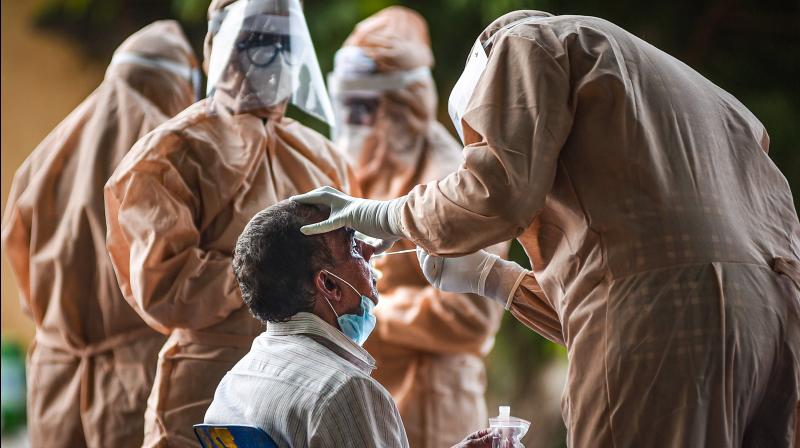
London- Scientists have claimed that there are six distinct ‘types’ of COVID-19, each distinguished by a particular cluster of symptoms in patients, findings, if validated, can help physicians better diagnose and monitor those infected with the novel coronavirus.
The yet-to-be peer reviewed study, published in the medRxiv preprint platform, used a machine learning algorithm to analyse data from a subset of around 1,600 users of the COVID Symptom Study app in the UK and US with confirmed COVID-19, who had regularly logged their symptoms between March and April.
It analysed if particular symptoms appeared together, and how this was related to the progression of the disease.
According to the scientists, led by those from King’s College London in the UK, the findings have major implications for the clinical management of COVID-19 patients.
“These findings have important implications for care and monitoring of people who are most vulnerable to severe COVID-19,” said Claire Steves, a co-author of the study from King’s College London.
They said the research can also help doctors predict who is most at risk and likely to need hospital care in a second wave of coronavirus infections.
The study noted that patient symptoms can fall under one of the six following categories: ‘flu-like’ with no fever, flu-like’ with fever, gastrointestinal, severe level one with fatigue, severe level two with confusion, and severe level three accompanied by abdominal and respiratory pain.
In the first category of patients who reported ‘flu-like symptoms with no fever, the scientists said the manifestations included loss of smell, muscle pains, cough, sore throat, chest pain, but no fever.
According to their analysis, those in the second category had headache, loss of smell, cough, sore throat, hoarseness, fever, and loss of appetite, and those in the gastrointestinal symptoms cluster had a combination of headache, loss of smell, loss of appetite, diarrhea, sore throat, chest pain, but no cough.
Under the ‘severe level one with fatigue’ category, the scientists said patients reported loss of smell, cough, headache, fever, hoarseness, chest pain, and fatigue, and those with the level two of severity expressed these same symptoms with the addition of loss of appetite, sore throat, confusion, and muscle pain.
In the most severe category, the study noted that patients experienced headache, loss of smell, loss of appetite, cough, fever, hoarseness, sore throat, chest pain, fatigue, confusion, muscle pain, shortness of breath, diarrhea, and abdominal pain.
According to the research, all people reporting symptoms experienced headache and loss of smell, with varying combinations of additional symptoms at various times.
It said some of the manifestations, such as confusion, abdominal pain and shortness of breath, are not widely known as COVID-19 symptoms, yet are hallmarks of the most severe forms of the disease.
The scientists also analysed if people experiencing particular symptom clusters were more likely to require breathing support in the form of ventilation or additional oxygen.
They discovered that only 1.5 per cent of people with cluster one, 4.4 per cent of those with cluster two and 3.3 per cent in cluster 3 required breathing support.
For clusters four, five, and six, the researchers said these figures were 8.6, 9.9, and 19.8 per cent respectively.
Nearly half of the patients in cluster six, according to the study, ended up in hospital, compared with just 16 per cent of those in cluster one.
People with cluster four, five or six symptoms tended to be older and frailer, and were more likely to be overweight, the scientists said, adding that these patients had pre-existing conditions such as diabetes or lung disease than those in the other types.
“If you can predict who these people are at day five, you have time to give them support and early interventions such as monitoring blood oxygen and sugar levels, and ensuring they are properly hydrated — simple care that could be given at home, preventing hospitalisations and saving lives,” Steves said.
Carole Sudre from King’s College London, one of the lead scientists part of the study, said the research illustrates the importance of monitoring symptoms over time to make predictions about individual risk and outcomes more sophisticated and accurate.
“This approach is helping us to understand the unfolding story of this disease in each patient so they can get the best care,” Sudre said.
“Being able to gather big datasets through the app and apply machine learning to them is having a profound impact on our understanding of the extent and impact of COVID-19, and human health more widely,” added Sebastien Ourselin, a senior author of the study from King’s College London.
Follow this link to join our WhatsApp group: Join Now
Be Part of Quality Journalism |
Quality journalism takes a lot of time, money and hard work to produce and despite all the hardships we still do it. Our reporters and editors are working overtime in Kashmir and beyond to cover what you care about, break big stories, and expose injustices that can change lives. Today more people are reading Kashmir Observer than ever, but only a handful are paying while advertising revenues are falling fast. |
| ACT NOW |
| MONTHLY | Rs 100 | |
| YEARLY | Rs 1000 | |
| LIFETIME | Rs 10000 | |









